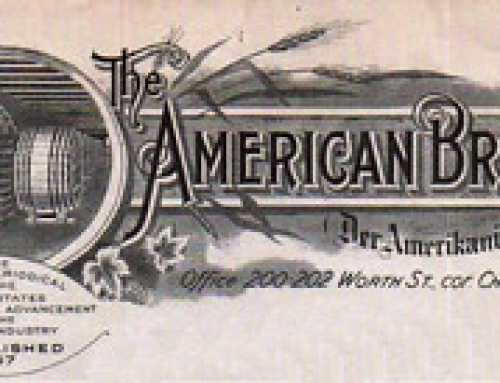As I began to write out a proposed production schedule last week, I quickly realized that I was signing myself up for a hell of a couple of months. It seems like every idea I’ve had in the last year though, the more I’m excited about it and the better of an idea I think it is, the more of a pain in the ass it is. As we get closer to our canning line arrival, the more ridiculous the schedule becomes. As it would be, the upcoming beers and events have me more excited than I think I’ve ever been about what we’ve got on the horizon.
Perhaps the most exciting bit of news is that our canning line ships tomorrow! The canning line was something that we’ve been talking about since my first interview with Matt and something we’ve been wanting since we opened. As I look back on the first year’s worth of our beer evolution though, I am actually a little bit relieved that we took this long to get the line…
I’ve been proud of every batch of IPA that we’ve brewed and while I originally thought that the first batch we brewed was as good as I could make it, every batch has actually received very minor tweaks to get us to this point. When I say minor things, it really has been extremely small tweaks… The first batch had a different water chemistry that left a little bit of a mineral character (which was intentional at the time, but after experimenting with water chemistry in other beers, I realized there was a better way to brew this beer) in the final product and has since been altered to make the mouthfeel as soft as possible. The fermentation temperature and yeast pitching rate were changed a few batches ago making the beer just a little bit juicier. Most importantly, in our first months we were working without hop contracts, buying everything from other breweries. While we were very selective about the breweries that we bought from and we took into account which hop growers and suppliers they bought them from themselves, we have since been able to source our hops on contracts from the two hop suppliers that I consider to be the best in the country. The batch that is in the fermenter now and getting canned on August 9th is undoubtedly the best batch that has been made yet. I think the beer in the tank now is the peak of what our IPA can be and it comes at the perfect time as it will be the first batch to go into cans. In addition to the IPA being canned on August 9th, one of our other most popular beers, Dank Fruit, will be canned on the same day. One week later, Over and Out (hoppy sour dry hopped with Citra) will be available in cans. The next canned beer after the first round will give us the opportunity to really show off our new hops with as Single Hopped Citra IPA.
After the first round of beers, it won’t be until the end of August that we can the Citra IPA because of our competition schedule. We entered our Pilsener, Kellerbier, Oktoberfest, and one of our upcoming Wet Hop Pale Ales into the competition and the lagers need to be brewed immediately after emptying the batches of canned beers so that they can have enough time to condition before the competition. This batch of Pilsener will be the last time for a while that we brew the same Pils recipe and will also be our first Pilsener batch in cans. It will kick off a series of experimental German style Pilseners which should be canned about every 3 weeks starting in late October.
The other lager on the schedule, Oktoberfest, is one that I’m particularly excited to brew and compete. After Pilseners, Oktoberfests are probably my next favorite style to brew and thanks in large part to Sierra Nevada’s Oktoberfests the past few years, American craft beer drinkers have really started to appreciate the pale Oktoberfest style that I prefer to brew over the amber colored O’fests that dominated the craft brewing landscape for so many years. The way that I prefer to brew Oktoberfests had been more common in Germany for many years, but not too many versions of the style have been exported to the USA which has led to the misconception that O’fests are amber colored, sweet, malty lagers. Our Oktoberfest will feature all traditional German ingredients including Vienna and Munich Malts from Bamberg. While the color may be pale, the rich malty characters do still dominate the flavor profile and the lager yeast we use is the same strain used by one of the oldest, most popular breweries in Bavaria which creates a ton of flavorful esters but still leaves a super crisp finish.
Around September 1st is when the brewing schedule really becomes crazy… We are planning a fresh hop festival for the 3rd week in September which will feature the release of 3 different fresh hop beers. We are going all out for these beers in a way that many people might consider to be a bit silly. Our distance from the best hop farms in America be damned, we are not allowing that to deter us from acquiring the best quality fresh hops in the country. On September 1st, Amarillo is being harvested in Oregon, being put immediately onto a plane, and arriving in Tombstone in less than 12 hours from the harvest where I will have a full kettle waiting for immediate use of these hops. On September 7th, Chinook and Cascade from Michigan will arrive in the same manner which will allow us to dry hop the Amarillo Pale Ale with fresh hops and again, a full kettle will be waiting for these hops immediate usage. The Chinook from Michigan is particularly exciting as our growers there have discovered that their unique soil conditions and climate make some intensely pineapple-y Chinook free of the spicy, pine characters that are normally exhibited by Chinook grown in the Pacific Northwest.
For the Amarillo Pale, it will feature 100% fresh hops. To feature nothing but fresh hops is actually a fairly uncommon practice due to the logistics of the schedule. Fresh hops really need to be used as quickly as possible (most people agree less than 24 hours), so dry hopping a beer with fresh hops only works if you use hops from two separate harvests. Most fresh hop beers use them in the whirlpool or the dry hop, but not in both and if used in the dry hop, they rarely get packaged due to the incredibly short shelf life. Because of the short shelf life, anything that is not sold at our wet hop fest will be distributed and available at retail accounts less than 72 hours after the cans are filled.
Immediately after these fresh hopped beers are dry hopped, I’ll be making a super quick trip up to Portland for an afternoon to select our Amarillo lots for next year. This is something that I consider to be critical for high quality hoppy beers and will serve to help us take a giant leap forward in our hoppy beer quality for the 2018 brew year. I never realized just how important lot selections are until I did my first one last year for Cascade which was the main hop in our highest rated beer this year. With lot selections, it allows the brewer to get one step further up the chain and closer to the growers. What a lot of people don’t realize is that a single variety can taste completely different from one grower to the next and that the differences can be large enough to make the same variety from different growers be completely unrecognizable. By doing a lot selection, we are getting the hops before the lots are all blended together so that we can ensure that we only have the very best of each variety without “filler” lots diluting the quality. While that does hurt the year-to-year consistency, it guarantees that we only ever have the absolute best available for each year.
Right when I return from the hop farms we will begin packaging the wet hop beers, throw a wet hop party, brew a round of beers that will feature an oak fermented porter, ESB, and Amber for draught only so that we can have some variety on our menu for our first anniversary party. After brewing those beers, we’ll have another quick trip to Portland to select our Idaho 7 lots for 2018, followed by a final round of beers before our first anniversary which will be celebrated on October 21st with Double Dry Hopped IPA, Another Exercise in Mediocrity, and Little Baby Wyatt all in cans.


Leave A Comment